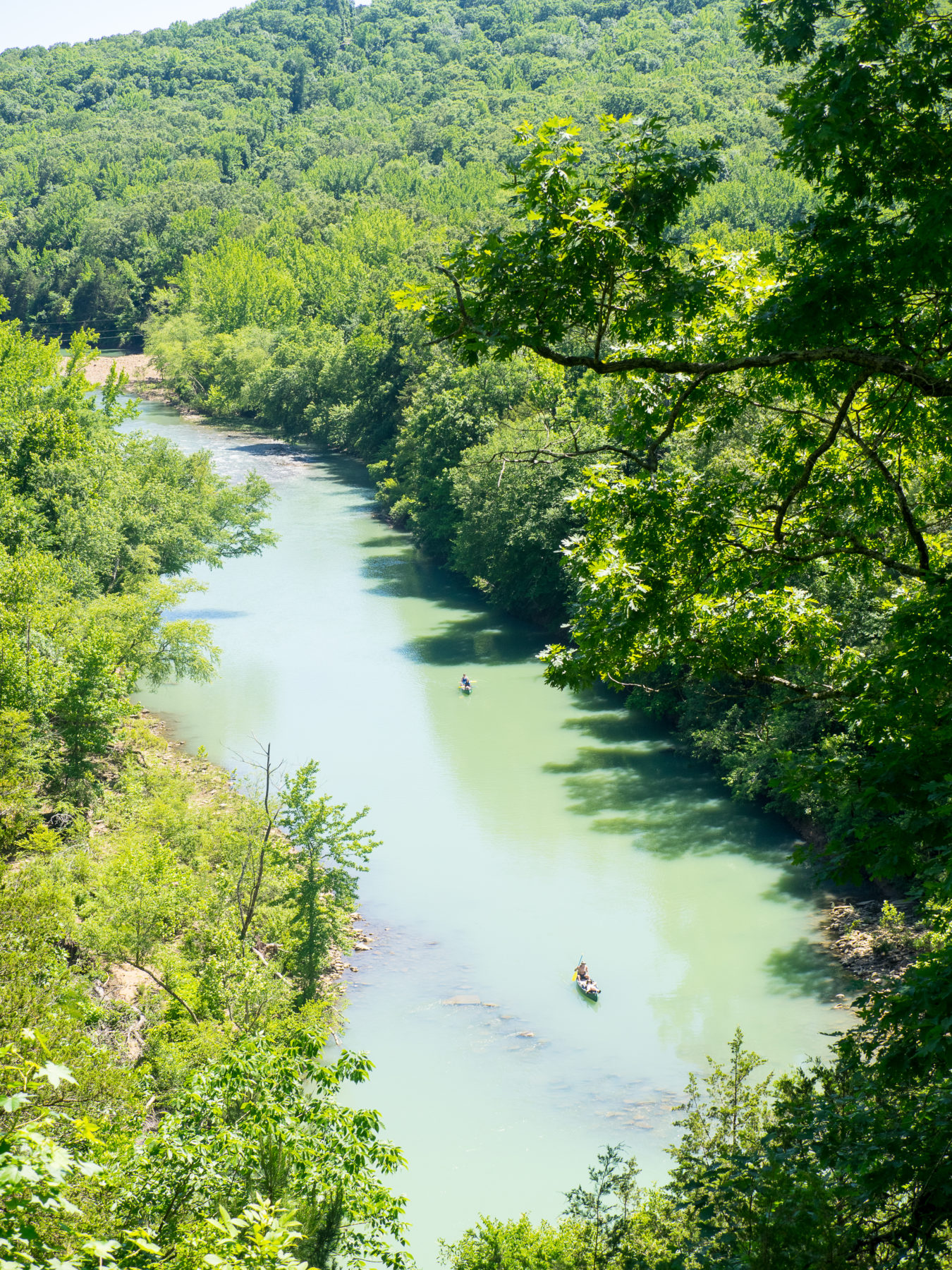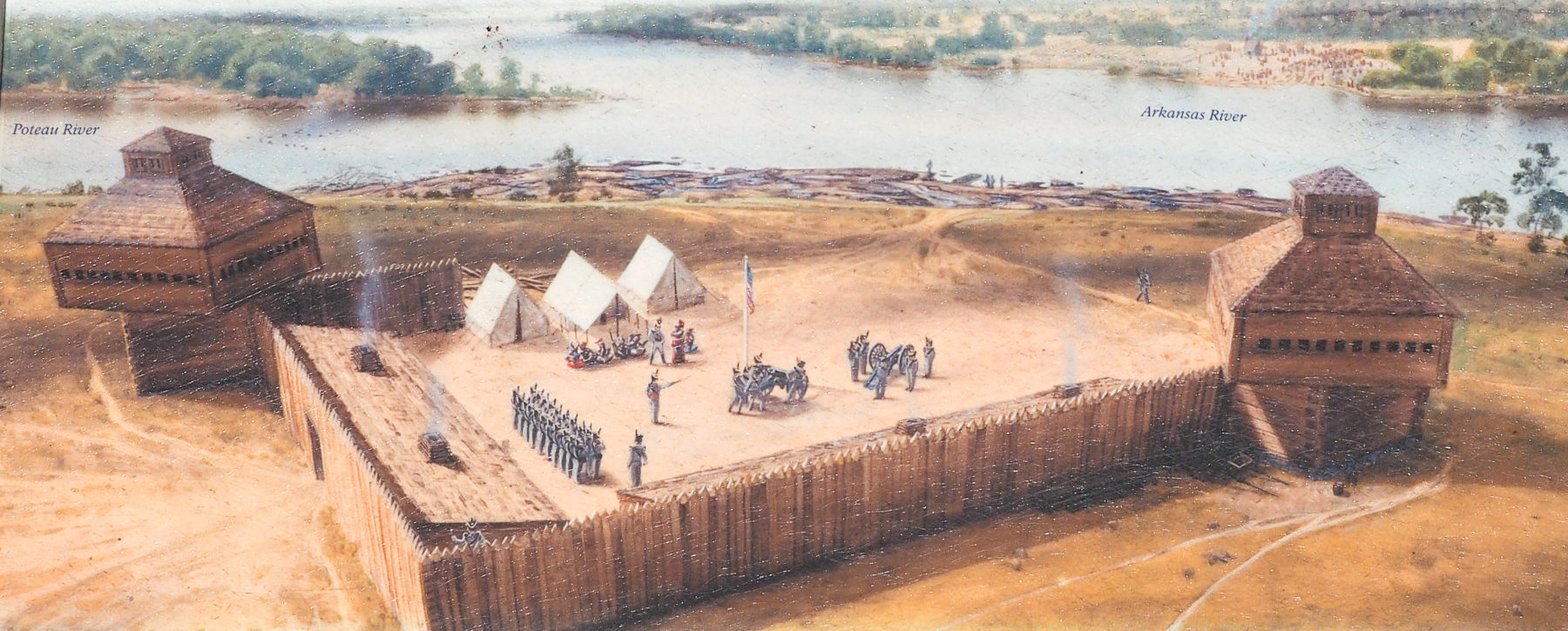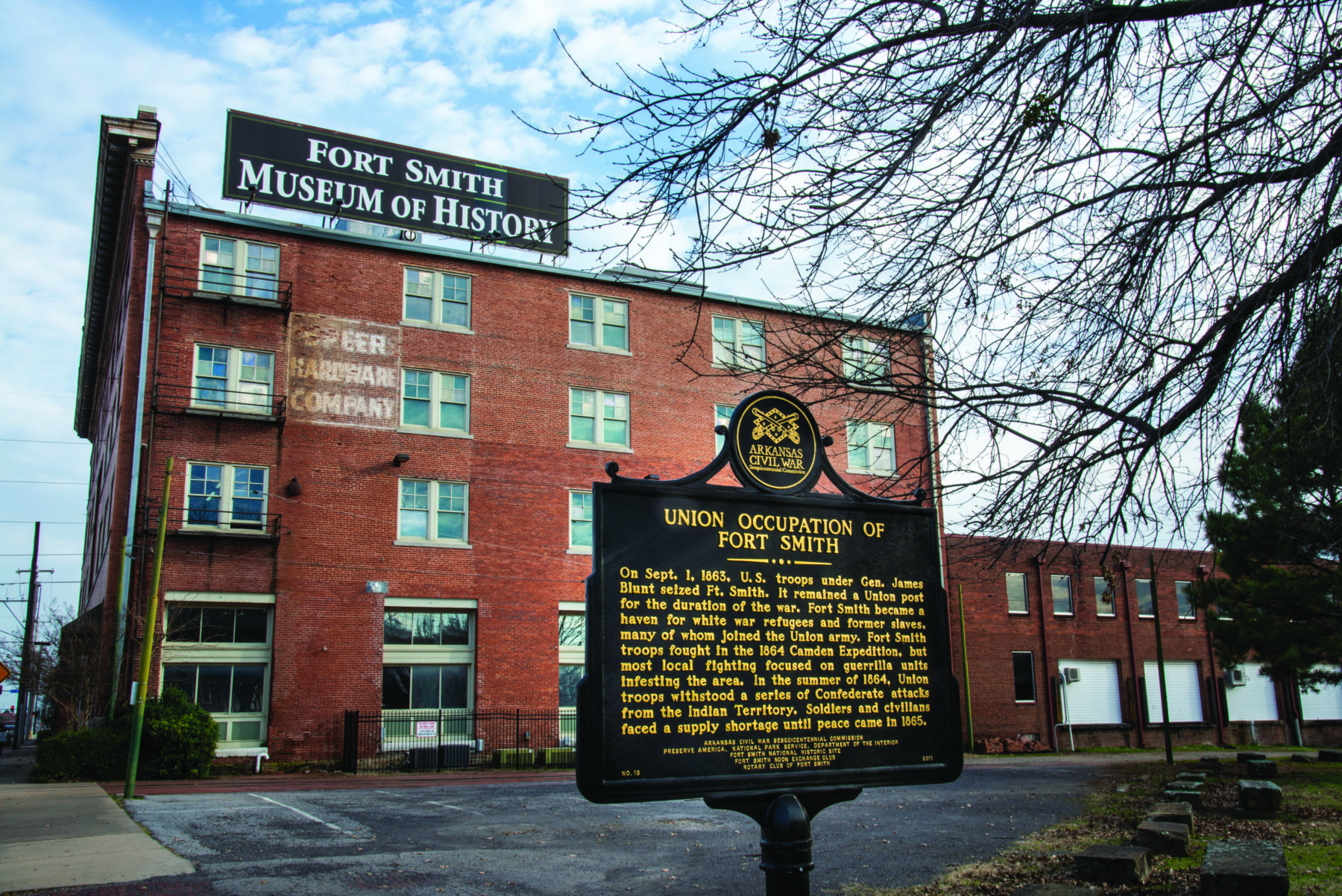Driving west on Interstate 40 through northwestern Arkansas, the exit signs streamed past like reminders of prior trips.
There was the time we drove scenic Highway 7 south to Hot Springs, stopping at the Buffalo River and hiking Pedestal Rocks along the way. The time we explored city parks and microbreweries in Little Rock. A mountain biking trip to Bentonville with buddies. A pair of camping trips at Big Piney Creek, near Dover. Whitewater kayaking on Richland Creek. Plus, mellower paddling trips to the Mulberry River, Lake Tenkiller, and other watery spots. But this time, the goal was something different.
I’d recently been reading about the Wild West, and I’d learned about the fascinating history of Fort Smith, including individuals like Deputy US Marshall Bass Reeves and the “Hanging Judge” Isaac C. Parker. The next time we were in the area, my wife and I decided to stop and check out what’s there.

Overlooking the Mulberry River. (Mike Bezemek)
We arrived at the Fort Smith National Historic Site early on a Sunday morning, and we had the place to ourselves. Not even the outdoor visitor center was open yet. A quick consultation of the site map pointed us to the River Trail, which loops around Belle Point, a bluff overlooking the confluence of the Poteau and Arkansas Rivers.
For hundreds of years, the area was home to Native American tribes, including the Mississippian peoples and later the Osage. The Spanish conquistador Hernando DeSoto’s expedition passed through the area in 1541 on a mission of conquest in search of gold. Next came French trappers and, in 1803, the United States, which acquired the area from France through the Louisiana Purchase.
The First Fort
Belle Point was the location of the First Fort, established on Christmas Day of 1817. At that time, the fort was on the leading edge of the western frontier. The purpose of the fort’s officers was to mediate peace between the Osage and relocating Cherokees, who were increasingly displaced from their traditional eastern lands.
Atop Belle Point, my wife and I circled the foundations of the First Fort. There’s not much left today, just stone outlines where the structure once stood. The early fort was a simple square stockade with log walls, each 132 feet long. At opposite corners stood a pair of two-story blockhouses. Inside, the fort housed barracks, storage rooms, shops, a hospital, and an ammunition magazine.

Illustration of the First Fort. (National Park Service)
The closest the soldiers came to combat was in April 1821, after a series of raids and skirmishes led to war between the Osage and Cherokee. The Osage leader Bad Tempered Buffalo and 200 warriors appeared on the banks of the Arkansas River across from Fort Smith. Soldiers ferried the Osage leader and seven war chiefs across the river to meet with the fort commander. When Bad Tempered Buffalo demanded gunpowder to fight the Cherokee, the fort commander refused. While the Osage party was ferried back to the western shore, the soldiers readied two six-pound cannons for action. Instead of initiating battle, the Osage withdrew into the woods.
By 1822, there were five companies of infantry stationed at the fort. But two years later, the new Fort Gibson was established 80 miles west inside an area considered Indian Territory. The first Fort Smith was soon abandoned.
Atop Belle Point, my wife and I completed a loop on the River Trail and walked a short way inland to the grounds of the Second Fort. Today, several of the main buildings are preserved with interiors to explore once Covid restrictions are lifted (for updates, visit nps.gov/fosm/).
The Second Fort
The story of the Second Fort begins with the Trail of Tears. In 1830, President Andrew Jackson signed the Indian Removal Act, which forced members of the so-called Five Civilized Tribes to leave their homes and relocate to Indian Territory in modern-day Oklahoma. Starting in 1831, the Choctaw began streaming into the area. Five years later came the Creeks, Chickasaws, Cherokees, and Seminoles. Over 10,000 Native Americans died on the Trail of Tears.
Arkansas became a state in 1836. In the meantime, a civilian community had developed next to Fort Smith, with merchants and taverns. Residents petitioned the US Government for a permanent military presence. Construction of the Second Fort began in 1839. By 1845, war with Mexico seemed likely, and the partially built fort was redesignated as a supply depot — a use that lasted for the next 25 years of westward expansion.
During the Civil War, the Second Fort was abandoned by Federal troops, occupied by Confederates, and regained by the Union near the end of 1863. During a weeklong offensive in 1864, Confederate troops failed to retake the fort. As the war came to an end, Fort Smith became a destination for civilian refugees seeking protection.
After the war, the frontier had moved so far west that Fort Smith was no longer a logical supply post. The 27 buildings of the Second Fort were abandoned in 1871. The following year, the US District Court, Western District of Arkansas, moved in. Thus began the fort’s Wild West era.
Post-Civil War, the Indian Territory had become a lawless territory and refuge for fleeing criminals. In 1875, President Ulysses S. Grant appointed Federal Judge Isaac C. Parker to clean up the territory. Parker’s court hired 200 Deputy US Marshals to patrol a 75,000-square-mile area. At Fort Smith, a gallows was constructed. The courthouse basement was converted into a makeshift jail, which came to be known as “Hell-on-the-border” due to overcrowding.
One of the first hired deputies was Bass Reeves. Formerly enslaved in Texas, Reeves likely fought for the Union in Indian Territory during the Civil War, becoming an expert with firearms. Despite being involved in numerous shootouts, Reeves was never wounded, and he claimed to have killed 14 men in self-defense. Over 32 years, he developed a reputation as a top lawman, regularly working in disguise and often bringing in tough outlaws that others could not.
The suspects were brought to Fort Smith, where they appeared before Judge Parker, who became known as the “Hanging Judge”. During a 21-year period, Parker presided over 13,000 cases. He sentenced 160 people to death, and ultimately 79 of those convicts were hanged for their crimes. In 1895, Parker’s jurisdiction was reduced to several counties in western Arkansas. The judge retired the following year.
The fort and grounds were granted to the city of Fort Smith that same year, and the jail was closed in 1914. The buildings and acreage saw various uses over the following 50 years, including a civic center, city offices, and a squatters’ camp. In 1961, the city donated the 11-acre site to the National Park Service (later expanded to 75 acres) to create Fort Smith National Historic Site.
Today, visitors can enter the restored courtroom of Judge Parker, as well as a replica gallows that stands outside. An active rail line passes through the historic site: part of the Arkansas & Missouri Railroad. The railroad offers several passenger train trips through northwest Arkansas that are particularly popular during fall colors, running between Van Buren (just across the river from Fort Smith), Winslow, and Springdale.

Fort Smith Museum of History. (Mike Bezemek)
After my wife and I finished our walking tour of the historic site, we decided to explore the town. Across the street, there’s the Fort Smith Museum of History, with exhibits focused on the contributions of the local citizens to the culture, politics, and economy of the area. For history buffs, a pair of relevant statues may be of interest. One depicts Bass Reeves, located in Pendergraft Park adjacent to the historic site. The other is of Judge Isaac Parker, in Gateway Park at the eastern edge of downtown.
In addition to having many restaurants and two breweries, a big highlight throughout the city is an extensive series of colorful building murals. These murals are part of The Unexpected, a contemporary art project that brings internationally renowned artists to the streets of Fort Smith. In total, more than 30 can be found. Subjects range widely, from 100-foot-tall portraits of local residents to symbolic imagery about the Trail of Tears, to an impressionistic scene of dancing Brazilian ranchers and farmers.
My wife and I only came for a morning visit, and as we drove out of town, we realized this wasn’t nearly enough time. With plenty more to see, we’ll definitely be stopping in Forth Smith again.
Outdoor Highlights
River Bluff Nature Trail
Beginning atop the high bluffs overlooking Ozark Lake, it winds down to their base. The trail then makes its way along the forest floor before traveling to the overlook shelter at the top of the bluffs. From the overlook, you have a view of the river as it begins its journey through Arkansas.
Lake Fort Smith State Park
Nestled in a scenic valley of the Boston Mountain Range of the Ozark Mountains, this state park is on the western side of Lake Fort Smith. Here, you can enjoy outdoor activities including camping, fishing, kayaking, swimming, mountain biking, hiking, and nature study.
Springhill Park Mountain Bike Trail
Located at Springhill Park, the trail is a 10-mile route with three loops that twist and wind like a spider web. Known as a “fast” trail by experienced mountain bikers, it’s home to monthly races and two annual competitions sanctioned by the International Mountain Biking Association.
Learn more about these and other outdoor highlights at fortsmith.org
Author: Mike Bezemek is a controbutor to Terrain Magazine
Top Image: Park at West End. (Experience Fort Smith)


Leave A Comment